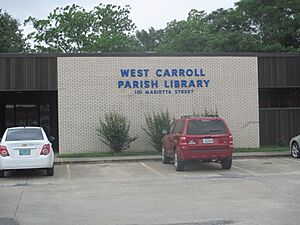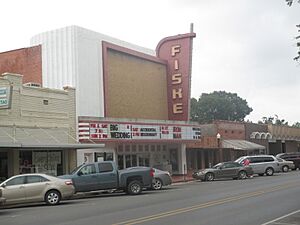West Carroll Parish, Louisiana facts for kids
Quick facts for kids
West Carroll Parish
|
|
|---|---|
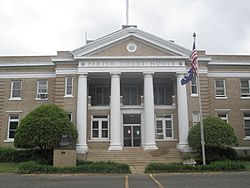
West Carroll Parish Courthouse in Oak Grove
|
|
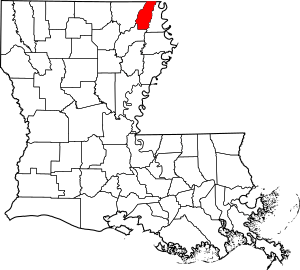
Location within the U.S. state of Louisiana
|
|
 Louisiana's location within the U.S. |
|
| Country | |
| State | |
| Founded | March 26, 1877 |
| Named for | Charles Carroll of Carrollton |
| Seat | Oak Grove |
| Largest town | Oak Grove |
| Area | |
| • Total | 361 sq mi (930 km2) |
| • Land | 360 sq mi (900 km2) |
| • Water | 0.9 sq mi (2 km2) 0.3%% |
| Population
(2020)
|
|
| • Total | 9,751 |
| • Density | 27.01/sq mi (10.429/km2) |
| Time zone | UTC−6 (Central) |
| • Summer (DST) | UTC−5 (CDT) |
| Congressional district | 5th |
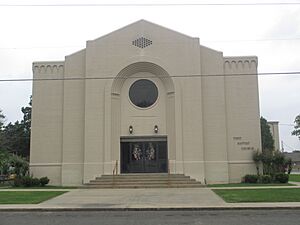
West Carroll Parish (French: Paroisse de Carroll Ouest) is a special kind of county called a parish in the northeastern part of Louisiana. In 2020, about 9,751 people lived here. The main town and government center is Oak Grove. The parish was created in 1877 when a larger area called Carroll Parish was split into two.
This area was once known for growing a lot of cotton. It was part of a larger region along the Mississippi River called the Natchez District.
Contents
Exploring West Carroll Parish History
Before it was divided, Carroll Parish was named after Charles Carroll of Carrollton. He was from Maryland and was the only Roman Catholic person to sign the United States Declaration of Independence. He was also the last person who signed the Declaration to still be alive.
Ancient Inhabitants of West Carroll
West Carroll Parish has a very long history. People lived here thousands of years before the United States even existed! In the southern part of the parish, you can find Poverty Point. This is a huge area with ancient earth mounds and circles. It's one of the biggest Native American earthworks in North America.
Experts believe that Poverty Point was built around 1500 BCE. It was a major trading center for the Poverty Point culture. This culture lived in the lower Mississippi River Valley. People traded goods here from as far away as Georgia and states near the Great Lakes. Later, tribes like the Choctaw and Chickasaw lived in this area.
Even though French and Spanish explorers visited this region from the 1500s to the 1700s, they didn't build lasting towns. They preferred areas closer to major rivers and the Gulf of Mexico.
How West Carroll Parish Grew
After the United States bought Louisiana in 1803 (the Louisiana Purchase), all of Northeast Louisiana was part of Ouachita Parish. In 1807, a minister named Moses Floyd settled near the Bayou Macon. A trading post called "Floyd" grew there, close to the Poverty Point site.
As more European-American people moved into Ouachita Parish, it was divided into smaller parishes. In 1832, Carroll Parish was created. This was a time when many local Native American tribes were forced to move to other lands.
The main town for Carroll Parish was Lake Providence, located on the Mississippi River. The western part of Carroll Parish grew, and its economy relied on growing cotton and cutting timber. By 1855, there were enough people to move the parish seat west of the Bayou Macon to Floyd. Floyd was a busy trading post because of steamboat traffic. A new courthouse was built in Floyd in 1857.
With the government moving to Floyd, more businesses and people came. Floyd became a busy frontier town with a hotel, post office, and stores.
The Civil War and Its Impact
In 1861, Louisiana decided to leave the United States and join the Confederacy. The Civil War caused disagreements among neighbors. Some people supported the Confederacy, while others signed an oath to the United States to protect their property.
There wasn't much fighting in this specific area during the Civil War. The Union army focused on controlling the Mississippi River. After the war, during the Reconstruction era, some local groups like the White League tried to stop African Americans from gaining their rights.
West Carroll Parish Today
In 1877, federal troops left Louisiana. Soon after, white leaders in the state government created West Carroll Parish. This new parish had more white residents. East Carroll Parish, which had many large cotton farms, had more Black residents.
Cotton and timber continued to be very important for the new parish. Steamboats were used for transportation on the Bayou Macon. But then, railroads were built, and steamboat traffic decreased. Towns like Pioneer, Forest, Oak Grove, and Kilbourne grew along the new railroad lines.
In 1909, Oak Grove became an official town. Many people thought it would become the main economic center of the parish. In 1915, people voted to move the parish seat from Floyd to a town on the railroad. Oak Grove won by a small number of votes.
In 1916, a new courthouse began construction in Oak Grove. A severe hail storm and tornado damaged the town and the courthouse that year. But by January 1917, the new courthouse opened. Oak Grove's Main Street became a busy place with many businesses.
After World War II, the parish continued to grow. Farmers started growing sweet potatoes instead of just cotton. A cannery was built, and new businesses like the Wells Lamont garment factory opened. In 1969, Shelton Ruffin started Ruffin Building Systems, which now makes metal buildings and ships them worldwide.
While large department stores changed shopping habits, Oak Grove's historic Main Street still has many businesses. Today, entertainment and shopping are important parts of the economy. The Thomas Jason Lingo Community Center and the renovated Fiske Theatre host many events.
Agriculture is still very important in West Carroll. The main crops are corn, rice, cotton, and sweet potatoes. The biggest employers include West Carroll Health Systems, the West Carroll School Board, Ruffin Building Systems, and Wal-Mart.
Geography of West Carroll Parish
West Carroll Parish covers about 361 square miles. Most of this area (360 square miles) is land, and a small part (0.9 square miles) is water.
Main Roads
Neighboring Areas
- Chicot County, Arkansas (north)
- East Carroll Parish (east)
- Richland Parish (south)
- Morehouse Parish (west)
Protected Natural Areas
Communities in West Carroll Parish
Towns
- Oak Grove (the parish seat)
Villages
Smaller Communities (Unincorporated)
- Goodwill
- Concord
- Bear Skin
- Green
- Redwing
- Chickasaw
- Old Floyd
- Darnell
- Terry
- Fiske Union
Law Enforcement
The West Carroll Sheriff's Office helps keep the parish safe. They have deputies who work full-time.
Population Information
| Historical population | |||
|---|---|---|---|
| Census | Pop. | %± | |
| 1880 | 2,776 | — | |
| 1890 | 3,748 | 35.0% | |
| 1900 | 3,685 | −1.7% | |
| 1910 | 6,249 | 69.6% | |
| 1920 | 8,857 | 41.7% | |
| 1930 | 13,895 | 56.9% | |
| 1940 | 19,252 | 38.6% | |
| 1950 | 17,248 | −10.4% | |
| 1960 | 14,177 | −17.8% | |
| 1970 | 13,028 | −8.1% | |
| 1980 | 12,922 | −0.8% | |
| 1990 | 12,093 | −6.4% | |
| 2000 | 12,314 | 1.8% | |
| 2010 | 11,604 | −5.8% | |
| 2020 | 9,751 | −16.0% | |
| U.S. Decennial Census 1790–1960 1900–1990 1990–2000 2010 |
|||
In 2020, there were 9,751 people living in West Carroll Parish. There were 4,084 households and 2,693 families.
| Race | Num. | Perc. |
|---|---|---|
| White (non-Hispanic) | 7,799 | 79.98% |
| Black or African American (non-Hispanic) | 1,338 | 13.72% |
| Native American | 37 | 0.38% |
| Asian | 13 | 0.13% |
| Other/Mixed | 239 | 2.45% |
| Hispanic or Latino | 325 | 3.33% |
Education in West Carroll Parish
The West Carroll Parish School Board runs the public schools in the parish. There are four high schools and one elementary school. These schools often do very well in state tests and in sports.
National Guard
The 921st Engineer Company (Vertical) is a part of the 528th Engineer Brigade. This unit is located in Oak Grove, Louisiana.
Notable People from West Carroll Parish
- Vance McAllister (born 1974), a businessman and politician.
- W. Spencer Myrick (1913–2002), a politician.
- Tony Joe White (1943–2018), a musician.
See also
 In Spanish: Parroquia de West Carroll para niños
In Spanish: Parroquia de West Carroll para niños


